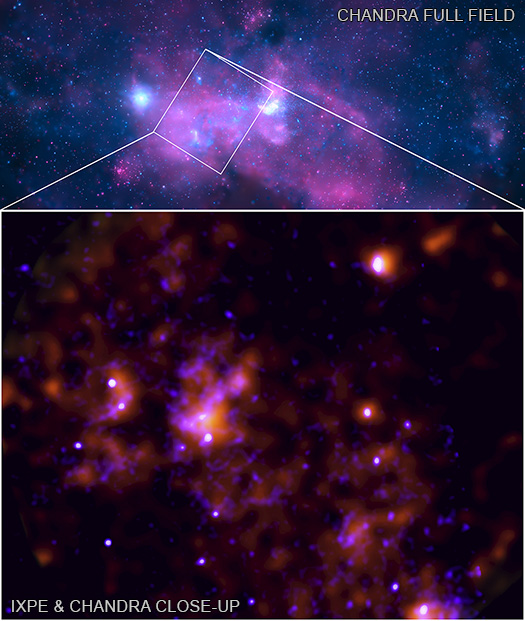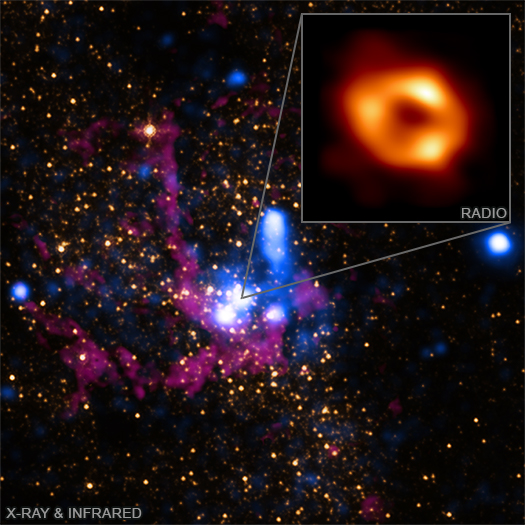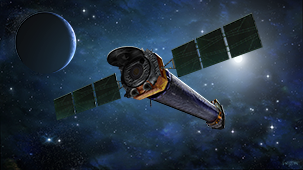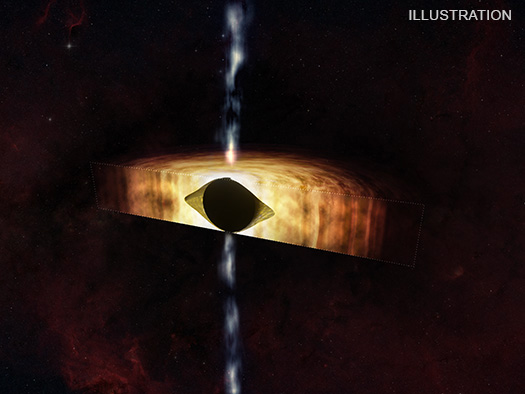Telescopes Show the Milky Way's Black Hole is Ready for a Kick
Submitted by chandra on Wed, 2024-02-07 17:55This artist’s illustration depicts the findings of a new study about the supermassive black hole at the center of our galaxy called Sagittarius A* (abbreviated as Sgr A*). As reported in our latest press release, this result found that Sgr A* is spinning so quickly that it is warping spacetime — that is, time and the three dimensions of space — so that it can look more like a football.
These results were made with NASA’s Chandra X-ray Observatory and the NSF’s Karl G. Jansky Very Large Array (VLA). A team of researchers applied a new method that uses X-ray and radio data to determine how quickly Sgr A* is spinning based on how material is flowing towards and away from the black hole. They found Sgr A* is spinning with an angular velocity that is about 60% of the maximum possible value, and with an angular momentum of about 90% of the maximum possible value.
NASA Telescope Data Becomes Music You Can Play
Submitted by chandra on Wed, 2023-11-15 10:39Credit: Composition: NASA/CXC/SAO/Sophie Kastner: Data: X-ray: NASA/CXC/SAO; Optical: NASA/STScI; IR: Spitzer NASA/JPL-Caltech; Sonification: NASA/CXC/SAO/K.Arcand, SYSTEM Sounds (M. Russo, A. Santaguida); Video Credit: NASA/CXC/A. Jubett & P. David
For millennia, musicians have looked to the heavens for inspiration. Now a new collaboration is enabling actual data from NASA telescopes to be used as the basis for original music that can be played by humans.
Since 2020, the “sonification” project at NASA’s Chandra X-ray Center has translated the digital data taken by telescopes into notes and sounds. This process allows the listener to experience the data through the sense of hearing instead of seeing it as images, a more common way to present astronomical data.
A new phase of the sonification project takes the data into different territory. Working with composer Sophie Kastner, the team has developed versions of the data that can be played by musicians.
Studies of Past X-ray Flares from Sgr A*
Submitted by chandra on Wed, 2023-06-21 13:35In a new Nature paper astronomers have reported exciting evidence that the supermassive black hole at the center of our Galaxy, Sagittarius A* (Sgr A* for short), produced an intense flare of X-rays about 200 years ago. Sgr A* is 28,000 light-years from Earth, but even from this considerable distance, if a similar flare occurred today then X-ray telescopes like IXPE and Chandra may be damaged if they looked at Sgr A*.
Currently Sgr A* shows frequent but weak outbursts, and has been referred to as a “sleeping giant” by members of the Event Horizon Telescope Collaboration.
In the new study astronomers learned about Sgr A*’s past outbursts by observing X-rays from clouds of gas around the supermassive black hole. While the primary X-rays from previous outbursts would have reached Earth in the past, X-rays reflected from clouds of gas will take a longer path and can arrive in time to be recorded by telescopes like Chandra and IXPE. This idea goes back decades, with the astronomers referring to a paper published in 1980. In the 1990s, several papers reported evidence for X-ray flares from the center of the Galaxy, including one in 1996 titled “ASCA View of Our Galactic Center: Remains of Past Activities in X-Rays?”.
Milky Way's Central Black Hole Woke Up 200 Years Ago, NASA's IXPE Finds
Submitted by chandra on Fri, 2023-06-16 17:24
Sagittarius A* / Galactic Center
Credit: Chandra: NASA/CXC/SAO; IXPE: NASA/MSFC/F. Marin et al; Image Processing: L.Frattare, J.Major & K.Arcand; Sonification: NASA/CXC/SAO/K.Arcand, SYSTEM Sounds (M. Russo, A. Santaguida)
These images show X-ray data of the area around the supermassive black hole at the center of the Milky Way galaxy. New data from NASA’s Imaging X-ray Polarimetry Explorer (IXPE) has provided evidence that this black hole — known as Sagittarius A* (Sgr A*) — had an outburst about 200 years ago after devouring gas and dust within its reach.
Looking at the Team Behind the Science
Submitted by chandra on Thu, 2022-05-12 11:41
Sagittarius A*: The Black Hole at the Center of the Milky Way Galaxy
Credit: X-ray: NASA/CXC/SAO; IR: NASA/HST/STScI. Inset: Radio (EHT Collaboration)
Many projects in astrophysics involve huge numbers of scientists and other collaborators — often ranging from senior professors to graduate students and undergraduates. A project like the EHT often requires smaller groups within these large collaborations to concentrate on different problems and questions.
The latest result about the Milky Way's central black using many different telescopes in concert with the Event Horizon Telescope (EHT) is an excellent example of such a successful web of groups working together with others in the project to make the sum even greater than its parts.
To learn more about the group behind the "multiwavelength" (MWL) observations that included Chandra and other telescopes, we asked Sera Markoff and Daryl Haggard, two of the coordinators of the EHT's MWL Working Group, a series of questions.
Magnetized Threads Weave Spectacular Galactic Tapestry
Submitted by chandra on Tue, 2021-05-25 15:34
The Galactic Center of the Milky Way
Credit: X-ray: NASA/CXC/UMass/Q.D. Wang; Radio: NRF/SARAO/MeerKAT
Threads of superheated gas and magnetic fields are weaving a tapestry of energy at the center of the Milky Way galaxy. A new image of this new cosmic masterpiece was made using a giant mosaic of data from NASA's Chandra X-ray Observatory and the MeerKAT radio telescope in South Africa.
The new panorama of the Galactic Center builds on previous surveys from Chandra and other telescopes. This latest version expands Chandra's high-energy view farther above and below the plane of the Galaxy — that is, the disk where most of the Galaxy's stars reside — than previous imaging campaigns. In the image featured in our main graphic, X-rays from Chandra are orange, green, blue and purple, showing different X-ray energies, and the radio data from MeerKAT are shown in lilac and gray. The main features in the image are shown in a labeled version.
Data Sonification: Sounds from Around the Milky Way
Submitted by chandra on Mon, 2020-09-21 13:37The center of our Milky Way galaxy is too distant for us to visit in person, but we can still explore it. Telescopes give us a chance to see what the Galactic Center looks like in different types of light. By translating the inherently digital data (in the form of ones and zeroes) captured by telescopes in space into images, astronomers create visual representations that would otherwise be invisible to us.
But what about experiencing these data with other senses like hearing? Sonification is the process that translates data into sound, and a new project brings the center of the Milky Way to listeners for the first time. The translation begins on the left side of the image and moves to the right, with the sounds representing the position and brightness of the sources. The light of objects located towards the top of the image are heard as higher pitches while the intensity of the light controls the volume. Stars and compact sources are converted to individual notes while extended clouds of gas and dust produce an evolving drone. The crescendo happens when we reach the bright region to the lower right of the image. This is where the 4-million-solar-mass supermassive black hole at the center of the Galaxy, known as Sagittarius A* (A-star), resides, and where the clouds of gas and dust are the brightest.
Users can listen to data from this region, roughly 400 light years across, either as "solos" from NASA's Chandra X-ray Observatory, Hubble Space Telescope, and Spitzer Space Telescope, or together as an ensemble in which each telescope plays a different instrument. Each image reveals different phenomena happening in this region about 26,000 light years from Earth. The Hubble image outlines energetic regions where stars are being born, while Spitzer's infrared image shows glowing clouds of dust containing complex structures. X-rays from Chandra reveal gas heated to millions of degrees from stellar explosions and outflows from Sagittarius A*.
In addition to the Galactic Center, this project has also produced sonified versions of the remains of a supernova called Cassiopeia A, or Cas A, and the "Pillars of Creation" located in Messier 16.
A New Galactic Center Adventure in Virtual Reality
Submitted by chandra on Tue, 2020-06-02 08:43Galactic Center VR: 2 Minute Video
Credit: NASA/CXC/Pontifical Catholic Univ. of Chile /C.Russell et al.
By combining data from telescopes with supercomputer simulations and virtual reality (VR), a new visualization allows you to experience 500 years of cosmic evolution around the supermassive black hole at the center of the Milky Way.
This visualization, called "Galactic Center VR", is the latest in a series from astrophysicists, and is based on data from NASA's Chandra X-ray Observatory and other telescopes. This new installment features their NASA supercomputer simulations of material streaming toward the Milky Way's four-million-solar-mass black hole known as Sagittarius A* (Sgr A*). The visualization has been loaded into a VR environment as a novel method of exploring these simulations, and is available for free at both the Steam and Viveport VR stores.
Giant X-ray Chimneys and Selection Effects
Submitted by chandra on Fri, 2019-03-22 07:51
Astronomers frequently talk about selection effects, where results can be biased because of the way that the objects in a sample are selected. For example, if distant galaxies above a certain X-ray flux – the amount of observed X-rays – are selected for a survey, the most distant objects will tend to be the most luminous, in other words producing the most X-rays.
For doing Chandra publicity we also have a bias, as we are always on the lookout for results where NASA’s Chandra X-ray Observatory data play a starring role. However, there are many papers where Chandra has an important supporting role instead, and other observatories are the stars. Our colleagues at the European Space Agency (ESA) and the University of California, Los Angeles (UCLA), have put out press releases on just such a result.
Galactic Center Visualization Delivers Star Power
Submitted by chandra on Thu, 2019-03-21 12:04To look around, either click and drag the video, or click the direction pad in the corner.
(For more information and images, visit: http://chandra.si.edu/photo/2019/gcenter/)
Pages
Please note this is a moderated blog. No pornography, spam, profanity or discriminatory remarks are allowed. No personal attacks are allowed. Users should stay on topic to keep it relevant for the readers.
Read the privacy statement


